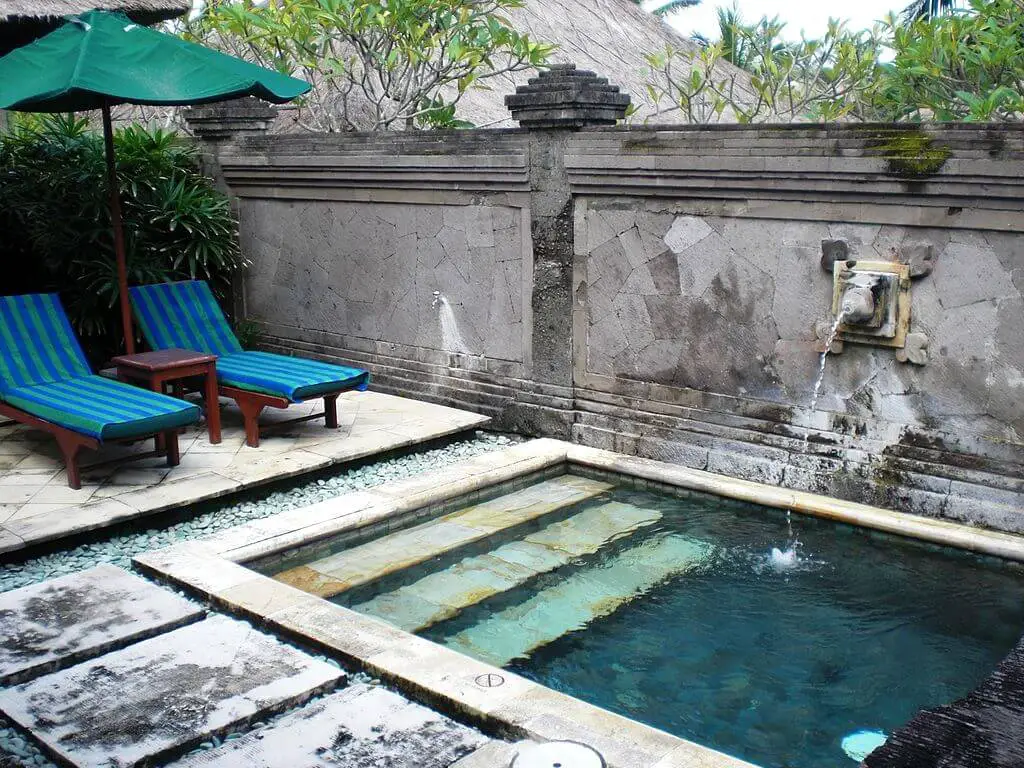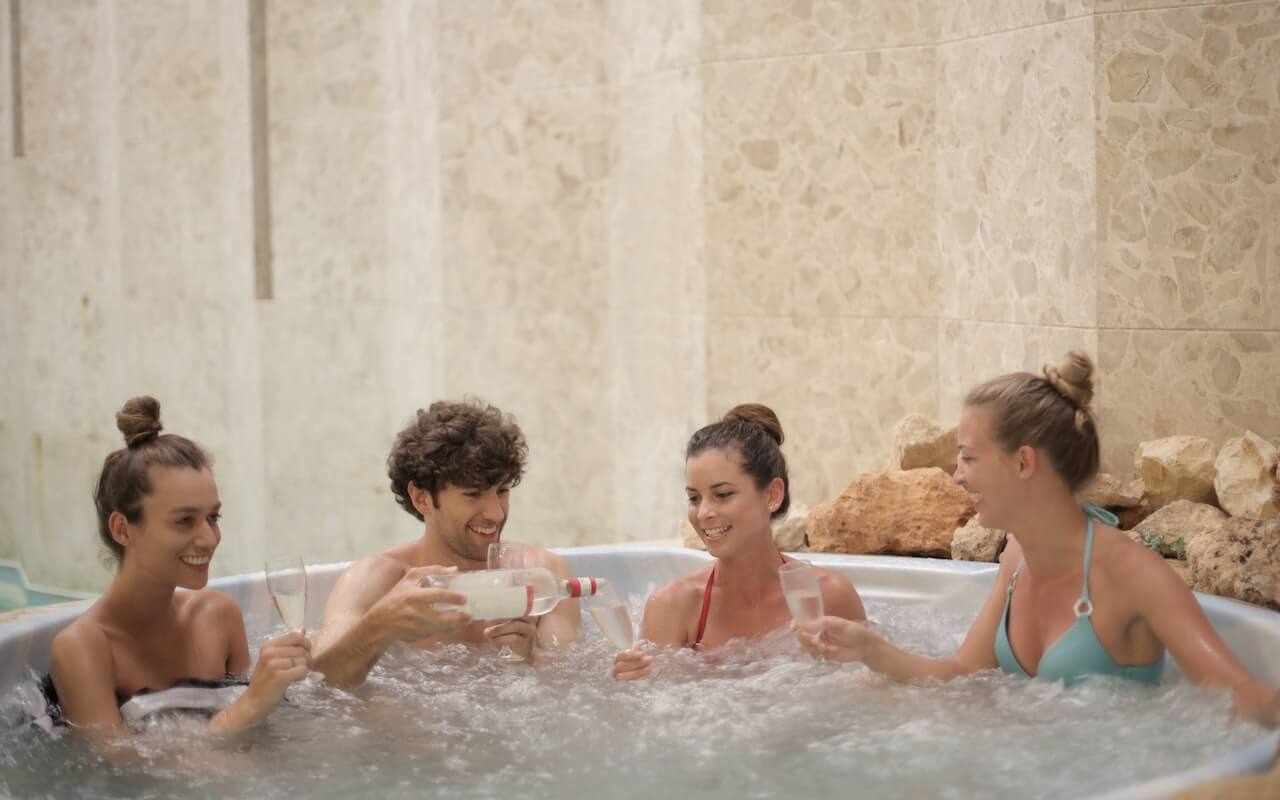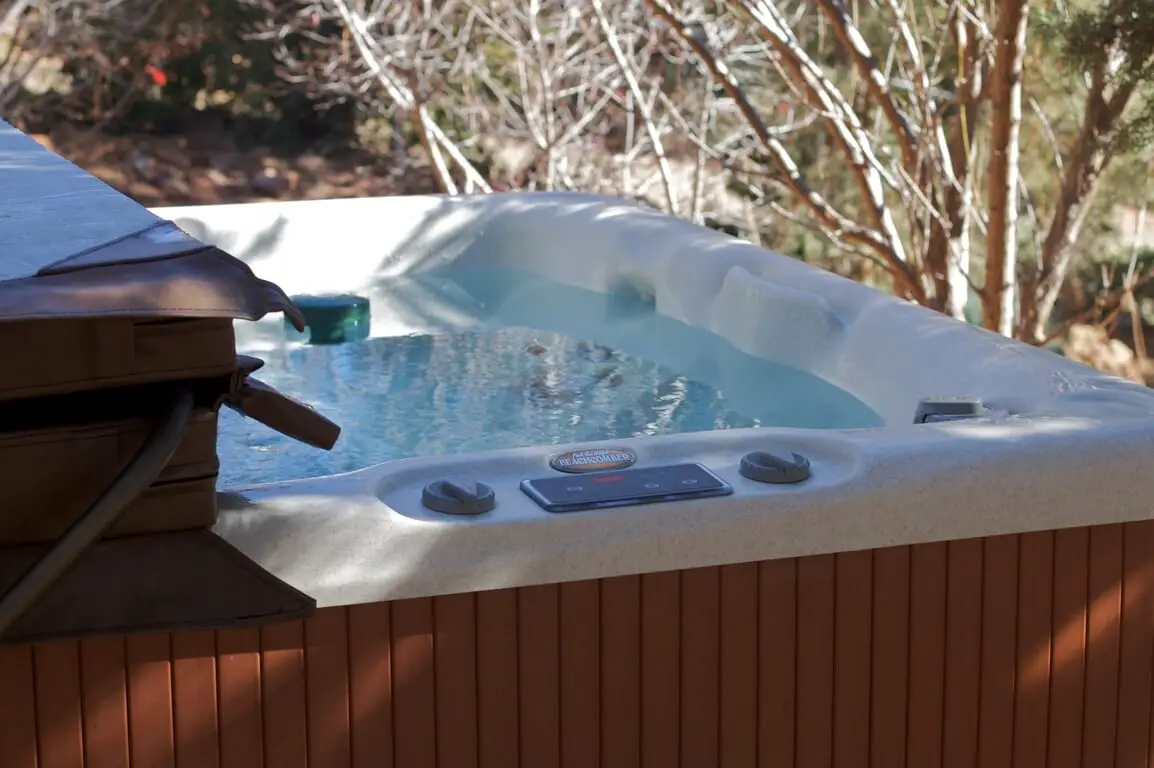When it comes to creating your own backyard oasis, you might be wondering whether a hot tub or a plunge pool is the right choice for you. Both options offer relaxation and therapeutic benefits, but they have some key differences that may influence your decision.
In this article, we’ll explore the pros and cons of hot tubs and plunge pools, including factors like depth, size, installation, and intended use. By the end, you’ll have a better understanding of which option best suits your needs and preferences, so you can make an informed decision for your backyard upgrade.
The Basics of Hot Tubs and Plunge Pools
Hot Tubs
A hot tub is a small pool filled with heated water, typically used for relaxation, hydrotherapy, and occasionally socializing. The water temperature in hot tubs usually ranges from 100-104 degrees Fahrenheit, which makes them perfect for soothing sore muscles and unwinding after a long day.
Hot tubs often come with jets that provide a massaging effect and can be found in various shapes and sizes to accommodate different preferences and backyard spaces. They can be installed in-ground or above ground, with a variety of materials and designs to choose from.
Plunge Pools

Plunge pools, on the other hand, are small, shallow pools typically filled with cold water. They are designed for cooling off or therapeutic purposes. The aim of plunge pools is to provide a refreshing experience, making them popular for those living in warmer climates or seeking a different kind of relaxation.
Generally, plunge pools are slightly larger than hot tubs, with dimensions between 4 to 7 meters in length, 2 to 3 meters wide, and about 1.2 meters deep. Like hot tubs, plunge pools can also be customized and built either in-ground or above ground, offering you flexibility in design and aesthetics.
Now that you know the basic differences between hot tubs and plunge pools, it’s time to consider the features and benefits of each in order to determine which one best suits your needs and backyard space.
Plunge Pool vs Hot Tub Comparison
Health Benefits
Hot tubs are known for their relaxing effects on sore muscles due to the heated water. The heat from the water can help to improve cardiovascular health by increasing blood flow and reducing blood pressure. It can also help to reduce stress and anxiety, which can have a positive impact on mental health.
Furthermore, hot tubs can be helpful for those suffering from arthritis or other joint pain, as the buoyancy of the water can help to reduce pressure on joints and ease discomfort.
While plunge pools may not offer the same level of relaxation as hot tubs, they do have their own unique health benefits.
The cold water can help to reduce inflammation and soreness in muscles after a workout, and it can also improve circulation by causing blood vessels to constrict and then dilate. This can help to flush out toxins and waste products from the body, promoting overall health and wellbeing.
Additionally, there is evidence that exposure to cold water may help to boost the immune system and increase the body’s resistance to illness.
Size and Shape
As mentioned, plunge pools can be between 4 to 7 feet in size, roughly the same size as a hot tub, but some can have a depth of 8 feet.
Plunge pools can be designed in a variety of shapes and sizes, depending on the available space and the intended use. While they are often rectangular, they can also be circular, oval, or even irregularly shaped. Additionally, plunge pools can be customized with a variety of features, such as jets, lighting, and heating systems, to create a unique and enjoyable experience.
Hot tubs, on the other hand, are typically designed for relaxation and socializing. They are designed to accommodate multiple people at once. Hot tubs can be round, square, or even triangular in shape, and they can be customized with a variety of features, such as built-in speakers, waterfalls, and lighting systems.
Water Temperature
The water temperature in hot tubs can be adjusted to meet individual preferences and needs. While the standard temperature range is 100-104 degrees Fahrenheit, some people may prefer a cooler or warmer temperature based on their personal preferences or health needs.
For example, those with arthritis or other joint pain may benefit from a slightly warmer temperature, while others may prefer a cooler temperature for a more refreshing experience.
Additionally, some hot tubs may have multiple temperature zones, allowing users to adjust the temperature in different areas of the tub for a more customized experience.
While plunge pools are typically filled with cold water, some models may offer the option to heat the water to a slightly warmer temperature (but generally not as hot as hot tubs).
This can provide a more relaxing experience while still offering the benefits of cold water therapy. Additionally, some plunge pools may be designed with a built-in heating system, allowing users to adjust the temperature as needed.
Aesthetics
When it comes to aesthetics, both hot tubs and plunge pools can be customized to fit the overall design of your backyard or outdoor space.
Plunge pools can be designed in a variety of shapes and sizes, and can be finished with a range of materials, such as tile or natural stone, to create a cohesive look. Additionally, plunge pools can be accessorized with features such as waterfalls, fountains, and lighting systems to create a unique and visually appealing space.
Hot tubs, on the other hand, are often designed with relaxation and entertainment in mind. They typically have built-in seating and jets, and can be customized with a range of features, such as built-in speakers, LED lighting, and waterfalls, to create a luxurious and visually stunning space.
Additionally, hot tubs can be finished with a variety of materials, such as wood or synthetic materials, to create a cohesive look that blends seamlessly with your outdoor space.
Social Benefits

In addition to their physical health benefits, both hot tubs and plunge pools can offer a range of social benefits.
Hot tubs, in particular, are well-known for their ability to bring people together and promote social interaction. The intimate setting of a hot tub can encourage closer conversations and more meaningful connections, making it a great space for entertaining guests or spending time with loved ones.
Additionally, hot tubs can be customized with a range of features, such as built-in speakers and lighting systems, to create a fun and inviting atmosphere for socializing.
While plunge pools may not be as focused on social interactions as hot tubs, they can still provide a fun and relaxing space for friends and family to enjoy.
Plunge pools can be customized with a range of features, such as seating and lighting systems, to create a comfortable and inviting atmosphere for socializing.
Additionally, the refreshing and invigorating experience of a plunge pool can be a great way to bond with friends and family and create lasting memories.
Versatility
When it comes to versatility, hot tubs have a clear advantage over plunge pools. Hot tubs can be customized with a range of features, such as built-in jets, seating, and lighting systems, to create a comfortable and relaxing space for a variety of activities.
These features can be adjusted to meet individual preferences and needs, providing a customized experience that can be enjoyed by people of all ages and abilities.
Additionally, hot tubs can be heated to a range of temperatures, allowing users to customize their experience based on their preferences.
While plunge pools may be less versatile than hot tubs, they can still provide a refreshing and invigorating experience for a variety of activities. Plunge pools can be used for cooling off after a workout or spending time outside on a hot day.
Additionally, some plunge pools may be designed with built-in seating or jets, providing a more comfortable and customizable experience. However, these features may be more limited than those available in a hot tub, and may not be suitable for all users.
Space Requirements
When it comes to space requirements, both hot tubs and plunge pools have a clear advantage over full-size swimming pools.
Both are generally smaller in size than swimming pools, making them a great option for those with limited outdoor space. They can be designed in a variety of shapes and sizes, depending on the available space and intended use.
Hot tubs tend to be even smaller than plunge pools and can be installed in additional locations, such as a deck or patio.
Installation
When it comes to installation, hot tubs have a clear advantage over plunge pools.
Hot tubs typically only require a simple electrical hook-up and a stable, level surface for installation, making them a quick and easy addition to your outdoor space. Additionally, hot tubs can be installed in a variety of locations, such as a deck or patio, and can be customized to fit the available space and intended use.
Plunge pools, on the other hand, can be more involved to install. They require excavation and potentially even permits, depending on local regulations. This can make the installation process more time-consuming and expensive than that of a hot tub.
Additionally, plunge pools may require additional features, such as a deck or landscaping, to create a cohesive and visually appealing outdoor space.
Installation Costs
The installation costs for both plunge pools and hot tubs can vary depending on several factors, such as the type of pool, size, and location.
According to Bob Vila, the cost to install a plunge pool ranges from $10,000 to $50,000, with the national average at $20,000. However, the cost to prepare land for your plunge pool ranges from $1,500 to $5,000, and building permits for plunge pools typically cost $400 to $1,800, depending on where you live.
Additionally, if you’re planning to build a concrete plunge pool, you shouldn’t expect to pay any less than $25,000, and in fact, depending on specific measurements, the total cost could be closer to $40,000.
The cost for a hot tub can range from $2,000 to $35,000 depending on the type of hot tub and other factors, once again according to Bob Vila. Additionally, installation costs between $160 and $1,500 are standard for above-ground hot tubs, and $3,000 to $16,000 for built-in styles.
Finally, hot tub electrical installation costs $800 to $1,600 for a dedicated circuit to the electrical panel, underground conduit, and wiring up to 100′, and to install a 220V GFCI outlet or subpanel near the spa.
Both hot tubs and plunge pools can be expensive to install, but plunge pools generally cost more and cause more of a headache than hot tubs.
Maintenance and Upkeep
When it comes to maintenance and upkeep, hot tubs have a clear advantage over plunge pools.
Hot tubs are typically designed to be energy-efficient and require minimal maintenance, making them a cost-effective addition to your outdoor space. Additionally, hot tubs typically only require basic maintenance, such as regular cleaning and water treatment, to keep them in good condition.
Plunge pools, on the other hand, can have higher associated costs due to water circulation, heating, and filtration systems. These systems can be more complex than those found in hot tubs, and may require more frequent maintenance and repair.
Furthermore, plunge pools may require more frequent water changes, which can increase the overall operating costs.
Environmental Impact
When it comes to environmental impact, both hot tubs and plunge pools have the potential to use significant amounts of water and energy for heating and filtration.
However, it’s important to note that the environmental impact of these features can be minimized by selecting energy-efficient models and following proper maintenance guidelines.
Hot tubs and plunge pools can be designed with a range of energy-efficient features, such as variable speed pumps and LED lighting systems, to reduce energy consumption and minimize their environmental impact.
Moreover, proper maintenance, such as regular cleaning and water treatment, can reduce water consumption and ensure that the system is operating at peak efficiency.
It’s also worth noting that both hot tubs and plunge pools can offer a range of environmental benefits, such as reducing the need for chemical treatments and providing a sustainable alternative to traditional swimming pools.
By selecting energy-efficient models and following proper maintenance guidelines, you can minimize the environmental impact of your outdoor space and enjoy its many benefits for years to come.
Making the Right Decision
Choosing between a hot tub and a plunge pool can be challenging, it’s up to you to make a decision based on your specific lifestyle, needs, and preferences. Let’s explore some factors that can help you decide which one is best for you.
Consider Your Lifestyle
Think about how you plan to use your new addition to your backyard. If you’re more focused on relaxation, stress relief, and soothing sore muscles, a hot tub with its warm, heated water might be the better choice.
On the other hand, if you prefer a refreshing way to cool down on hot days or engage in therapeutic cold-water immersion, a plunge pool could be more suitable for you.
Think About Your Needs and Preferences
Space and budget constraints should also be taken into account when deciding between a hot tub and a plunge pool. Generally, hot tubs require less space and have lower monthly operating costs when compared to a plunge pool, making them an attractive option for homeowners with limited outdoor areas and budgets.
Another factor to consider is the maintenance and upkeep of both options. A plunge pool may require fewer materials for construction and surrounding areas, potentially reducing the initial investment.
With that said, it’s important to remember that both hot tubs and plunge pools will still require regular cleaning and maintenance to keep them in optimal condition.
In closing, carefully considering your lifestyle, needs, and preferences will guide you in the right direction when choosing between a hot tub and a plunge pool. By weighing the pros and cons, and factoring in your personal preferences and circumstances, you’ll be able to create the perfect backyard oasis that meets your needs and enhances your overall quality of life.
Photo Credit: Alan Levine CC BY 2.0


